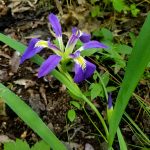 Also called short-stemmed iris, this rhizomatous perennial and a member of the iris family, Iridaceae, that also includes crocus, gladiolus, and freesia. It is native to Ohio southwest to Nebraska, south to Texas, east to Florida and north to Kentucky where it grows in moist to wet soils in swamps, wet meadows, marshes, bottomlands, and along streams, rivers, lakes, and ponds. Habitat destruction has caused the plant to become rare in many places. Plants grow from a shallow branching rhizome and have long sword like leaves 10-20″ long that are glossy, bright green and arching. In June 3-6 large flowers are carried on a zig-zag 5″ long stem that often lean or lie on the ground. The flowers are light to dark shades of bluish-purple with white to yellow or pale green markings. Plants may not bloom every year and even when they do the flowers are usually hidden by the foliage so use is the garden is limited. The flowers, however, are very attractive in the vase. The genus name, Iris, is the name of the Greek goddess of the rainbow and refers to the many colors of iris flowers. The specific epithet, brevicauli, comes from the Latin words brevis meaning brief, and caulis meaning stalk of a plant, and refers to the length of the stem.
Also called short-stemmed iris, this rhizomatous perennial and a member of the iris family, Iridaceae, that also includes crocus, gladiolus, and freesia. It is native to Ohio southwest to Nebraska, south to Texas, east to Florida and north to Kentucky where it grows in moist to wet soils in swamps, wet meadows, marshes, bottomlands, and along streams, rivers, lakes, and ponds. Habitat destruction has caused the plant to become rare in many places. Plants grow from a shallow branching rhizome and have long sword like leaves 10-20″ long that are glossy, bright green and arching. In June 3-6 large flowers are carried on a zig-zag 5″ long stem that often lean or lie on the ground. The flowers are light to dark shades of bluish-purple with white to yellow or pale green markings. Plants may not bloom every year and even when they do the flowers are usually hidden by the foliage so use is the garden is limited. The flowers, however, are very attractive in the vase. The genus name, Iris, is the name of the Greek goddess of the rainbow and refers to the many colors of iris flowers. The specific epithet, brevicauli, comes from the Latin words brevis meaning brief, and caulis meaning stalk of a plant, and refers to the length of the stem.
Type: Herbaceous perennial
Bloom: Blush purple flower with white and yellow to greenish markings on zig-zag stem in June
Size: 8-12″ H x 8-12″ W
Light:Full sun to partial shade
Soil:Fertile, wet to moist, slightly acid
Hardiness: Zones 4-8
Care: Deadhead to maintain vigor; divide when necessary.
Pests and Diseases: None of significance
Propagation: Division (seed possible but very slow)
Companion Plants:Pickerel rush, cardinal plant (Lobelia cardinalis), canna
Photo Credit: Wikipedia